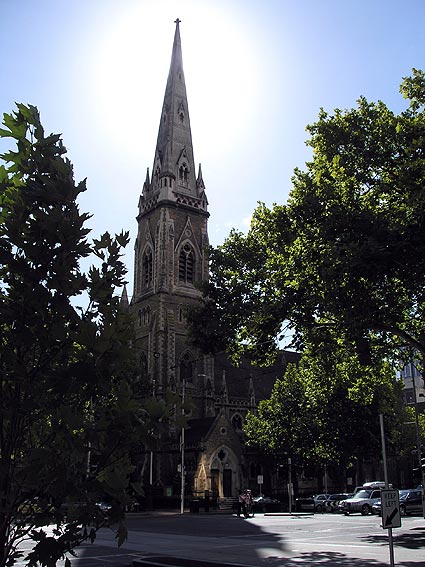
The Scots' Church, Melbourne: the exterior from the corner of Collins and Russell Streets
[photograph by Simon Colvin (May 2007)]

The Scots' Church, Melbourne: the exterior from the corner of Collins and Russell Streets
[photograph by Simon Colvin (May 2007)]
Historical and Technical Documentation by John Maidment
© OHTA, 2013 (last updated September 2018)
The present site for the church was obtained in 1839. Earlier, in 1838, the congregation met in a temporary church in Collins Street West where a school was also opened by the Revd James Forbes. On 18 February 1839 Forbes wrote to Robert Hoddle with the list of allotments they were able to get from the Crown - the present site of the church and the adjoining buildings. In June 1839 a schoolroom was being erected which was also used as a church.
The first church was designed by Samuel Jackson and opened on 3 October 1841. In January 1857 it was decided to place a tower and spire on the church - the existing building was retained but rebuilt in Decorated Gothic style. David Ross was the architect and the work was completed in 1859. Only the bluestone fence survives from this building. Site works for the present church began in 1872 and the previous building was demolished. The well-seasoned planks from the pews were sawn up to make into wooden trackers for the 1874 organ.
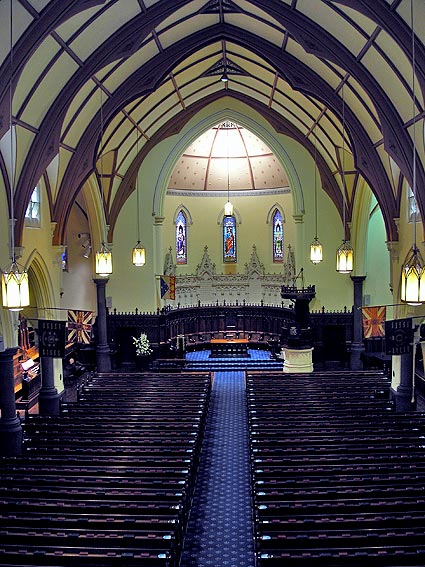
The Scots' Church, Melbourne: the interior from the rear gallery
[photograph by Simon Colvin (May 2007)]
The present church was opened in November 1874. The architects were Reed & Barnes and the contractor David Mitchell – Mitchell was Dame Nellie Melba's father. The architects were the leading firm in Melbourne at the time and designed such prominent buildings as Melbourne Town Hall, the Independent Church, Wesley Church, the State Library and, later, the Exhibition Building. It was built at a cost of more than £20,000 excluding the fittings. The height of the tower and spire was at the time 211 feet, although this was later reduced after a lightning strike in the 20th century – this was the highest in Victoria at the time. The building was constructed from Barrabool stone with New Zealand Kakanui freestone for the dressings.
The building has a sloping floor, focussing upon the apse, where there was originally a splendidly carved stone pulpit. This arrangement was later changed and the apse now contains the communion table, elders chairs and a wooden pulpit to the right, all to the design of H.H. and F.B. Kemp. The reorganized apse was dedicated in March 1930. The pews are of cedar. The original carving was executed by Mr Brain – presumably this included the arcading in the apse and the organ case, all designed by Reed & Barnes. The interior is one of considerable simplicity in design and decoration, showing a sense of overall restraint.
THE NEW SCOTS' CHURCH,
COLLINS-STREET.Of all the many classes of buildings which are being erected in and around the city, there are none which exhibit more the increased wealth of the community, and the improvement in the public taste, than places of worship. Whatever the religious tendencies of the age may be and notwithstanding the diminution in the number, at any rate of male, church goers, the various denominations seem to vie with each other in erecting handsome and costly structures. The latest of these is the new Scots Church at the corner of Collins and Russell streets and there can be little difference of opinion that for elegance of design and elaboration of detail its exterior surpasses that of any other similar edifice in Melbourne. The site is commanding, and the building is in every way worthy of it. The principal material used is Barrabool-hill (Geelong) stone, which being of a neutral warm colour contrasts exceedingly well with the pure white New Zealand freestone plentifully employed in the dressings. The style of architecture is early English, and the general plan is cruciform. Looking at the church from Collins-street on the right hand of the facade stands the tower with the main gable of the nave in the centre, and a porch and turret on the other side. The tower is at present only partly erected, but it will be finished with a spire carried to a height of 211ft, which, when completed, will be the most conspicuous elevation in the city. The first four storeys are solid in character. Above these will be the belfry, having large louvre windows with pointed gables, surmounting which will be the parapet from which springs the spire. Its shape will be square, with the angles taken off and it is to be pierced with numerous gabled dormer windows. Three angles will be finished off with the graceful pinnacles of which there are so many about the church, and the fourth with the stair turret. In the centre of the front or the main gable is a very large traceried window which lights the nave, whilst the wall above, following the rake of the roof, is relieved by an open arcade in white stone, which forms one of the most peculiar and pleasing features of the building, imparting, as it does, an air of lightness and beauty to the edifice. The apex is surmounted by a cross which by the way, is much more freely used than is usually the case in Presbyterian churches, every gable being terminated by one. On the western side of the facade is an entrance porch approached by a flight of steps, and attached to an octagonal turret finished with a stone spire. The side elevations are divided into five bays, separated by buttresses surmounted by pinnacles, there being in each bay a two light window above and below. The parapets and enrichments are of pierced and handsomely carved white stone. In the end of the transept is a large traceried window similar to that in the front and at the other extremity is another entrance porch. The roof is covered with slates cut into various shapes and the ridge is finished with an ornamental iron cresting. At the junction of the nave with the transept the roof is surmounted by an elegantly-shaped spire ventilator. The appearance of the interior, which in its unfinished condition does not approach that of the exterior, is nevertheless very fine, the ample space and bold curves of the roof giving an effect of extreme lightness to the building, which, when the walls are adorned and the windows filled with coloured glass, will be vastly improved. The body of the church consists of a nave 46ft. and side aisles of 8ft. wide, from which the nave is divided by pointed arches supported by polished Malmsbury bluestone pillars. The aisles by "a happy thought" are intended to serve only as passages, the whole of the congregation being seated within the nave and transept so that the columns form no obstruction, as they ordinarily do, to the view. The nave, which is lighted by clerestory windows and the large window in the south gable, is crossed by a transept 30ft. in width behind which is on apse, or semicircular recess lighted by three lancet windows, and forming a platform for the pulpit, which is of carved freestone. One end of the transept is fitted up as a chamber for the organ, which is being erected by Messrs. McKenzie and Co. The ceiling is plastered and divided into panels by gothic oak principals and purlins, and when properly painted and decorated will have an excellent appearance. The two principal entrances are connected by a lobby at the south end, winch is cut off from the church by an open screen with a small gallery above it. The total internal length of the building is 126ft. Ample provision is apparently made for ventilation, both in the floors and ceiling, and all the doors open outwardly, in consonance with the requirements of the Central Board of Health. The architects are Messrs. Reed and Barnes, and the contractor Mr. David Mitchell, the amount of contract for the building alone without the fittings being £20,000. The seats, &c., which are to be of French polished cedar, will be supplied by Mr. Mc Ewan. These with the organ and other fittings, will cost an additional £5, 000. At present temporary benches are provided. It is intended to send to England for gasaliers, sunlights being meanwhile used. The carving about the place which from its admirable quality is worthy of notice, has been executed by Mr. Brain. The church, although unfinished, will be opened for Divine service on Sunday.1
Some of the significant events that have taken place in this building include the funerals of Dame Nellie Melba and Sir Robert Menzies, the wedding of aviator Charles Kingsford Smith and several visits by Her Majesty the Queen.
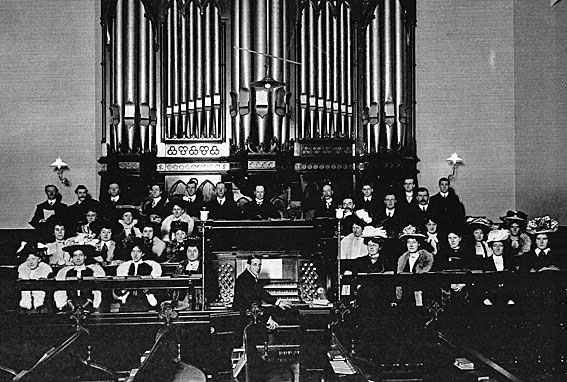
The Scots' Church, Melbourne: the Mackenzie, Lee & Kaye organ with J.R. Edeson at the console
[photograph by John Maidment from The Scots' Church Archives]
The original organ was built by Mackenzie, Lee & Kaye in 1874 and was (with the Hill & Son organ at St Andrew's Cathedral, Sydney) one of the two largest church organs in Australia at the time. It was also one of the first to appear in a Presbyterian Church, where use of such instruments was earlier opposed. It was a three-manual organ of 37 stops with barker lever and mechanical action. Additional reed stops were supplied in 1883 by the London firm of Hill & Son, these including the Great Trumpet 8 and Clarion 4, and the Pedal Trombone 16, of wood. The tonal design was informed by contemporary Hill & Son practice; Mackenzie had come to Melbourne to erect the Hill organ in Melbourne Town Hall. The console was detached from the organ and appears to have drawstops with coloured faces, to distinguish the different divisions.
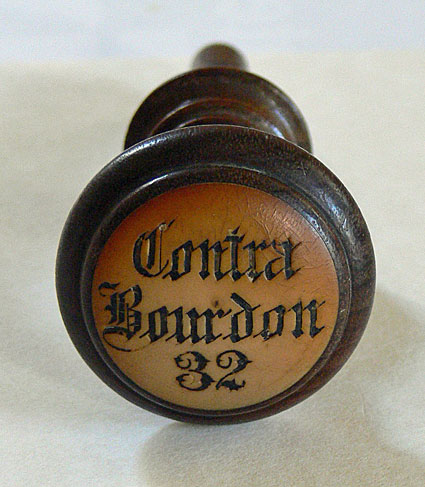
The Scots' Church, Melbourne: Contra Bourdon 32 drawstop
[John Henwood collection]
In July 1876 it was reported:
THE SCOTS CHURCH
There was a large gathering of this congregation - as well as of many others who do not belong to it, at the church in Collins-street last night on the occasion of an organ recital which was given by J.R. Edeson, the organist to the church, assisted in various vocal selections by Miss Pitts, soprano, Miss Jukes, contralto; and Mr. E. Exon, tenor. Before the musical performance commenced, a meeting was held at half-past 7, at which the Rev. C. Strong presided, which was opened and closed with prayer. The business at this meeting was the naming of eight gentlemen for election to supply the places of an equal number who retire annually by rotation from the board of management. The following were those nominated :-John Anderson, John H. Blackwood, the Hon. John Cumming, Alexander Dick, John Falconer, James Lyall, Dr. Alexander Morrison, Thomas Russell, and William Strachan, It was also agreed to hold a social meeting of the congregation in the Town-hall on Wednesday, the 23rd August, that day being the anniversary of the arrival of the Rev. C. Strong.
The musical performance was full of interest, both on account of the organist, who is comparatively new to Melbourne, and of the instrument he played upon, which is one of local manufacture and the next best to, although a long way after, the magnificent organ in the Town-hall. The instrument at the Scots Church was built by Messrs. Lee and Kaye, associated with Mr. Mackenzie, who came here from the house of Hill and Sons in London. We have described this organ before in the terms of the general specification. In its finished condition it presents a very handsome appearance, although it is hidden away from at least one-half of the congregation. The building generally in its interior fittings, and especially as regards the gas lighting arrangements, shows that a large amount of money must have been expended under the guidance of very good taste. Mr. J.R. Edeson, the organist, had most of the work to do, his selections consisting of Mendelssohn's sonata No. 1, the first movement from Spohr's quartett in G minor, a "Fanfare" by Lemmens, the fugue in D minor by J.S. Bach, the concerto in B flat by Handel, the offertoire No. 5 by Lefebure Wely, an adagio movement by Mozart, the chorus "But the Waters" by Handel, and a march by Scotson Clark. In his performance of these nine different numbers, Mr. Edeson displayed good taste in selection and grouping, and power in the management of the numerous stops contained in the instrument. The "Fanfare" mentioned above was an excellent performance, and the performance of the Handel concerto No. 2 was admirable. In the grand chorus by Handel, " But the waters,'' the player showed a masterful command of pedal passages; and throughout the whole evening, whether as solo organist or in playing accompaniments to the voice parts, he acquitted himself in a manner most satisfactory to the congregation who heard him. And this was afterwards expressed in a vote of thanks, proposed by Mr. Thomas Bailey, in which the vocalists were also included.2
The specification of the organ was:
| GREAT Double Open Diapason Open Diapason Stopped Diapason Harmonic Flute Cone Gamba Principal Wald Flute Twelfth Fifteenth Mixture Trumpet Clarion Swell to Great Sub Swell to Great Unison Swell to Great Super |
16 8 8 8 8 4 4 2-2/3 2 V 8 4 |
Hill 1883 Hill 1883 |
|
| SWELL Bourdon Open Diapason Stopped Diapason Keraulophon Principal Fifteenth Mixture Cornopean Oboe Clarion |
16 8 8 8 4 2 IV 8 8 4 |
||
| CHOIR Viol di Gamba Dulciana Gedact Harmonic Flute Gemshorn Harmonic Vox Angelica Clear Flute Clarionet Orchestral Oboe Vox Humana Tremulant Choir Sub Octave Swell to Choir |
8 8 8 4 2 II 4 8 8 8 |
(* stops enclosed) 8 * * * * * |
|
| PEDAL Contra Bourdon Open Diapason Bourdon Principal Trombone Great to Pedal Swell to Pedal Choir to Pedal |
32 16 16 8 16 |
wood Hill 1883 |
Compass: 58/30
3 composition pedals to Great
3 composition pedals to Swell
2 composition pedals to Choir
Total number of pipes: 2,4343
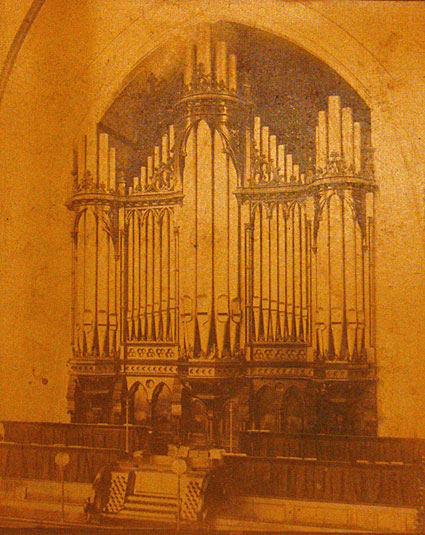
The Scots' Church, Melbourne: the Mackenzie, Lee & Kaye organ
[photograph from Warwick Anderson, owned by William Anderson, organbuilder]
In June 1883, it was reported:
The organ in the Scots Church having lately I been improved and enlarged, Mr. J. R. Edeson and the choir gave a vocal and instrumental concert in the church last night. The building was crowded. Mr. Edeson, the organist of the church, being unable to play any of the works of the great masters with satisfaction on the original organ, which was built in 1875, submitted to the board of management some time ago a plan for enlarging and improving it, and these alterations have been successfully made by Mr. G. Fincham. Among the improvements and additions are -Re-stocking and re-fitting of the great and pedal actions, new action to swell and choir, remaking of pneumatic chests and pallets, renewal and enlargement of choir and pedal sound-boards, revoicing and regulation of the old stops, and the addition of various reeds. The engines for working the bellows have also been improved, and are now perfectly silent. On the improvements over £100 has been spent, making the total cost of the instrument about £2,500. It is said to be now in every respect the largest and finest church organ in the colony. Certainly it gave intense satisfaction last night, and fulfilled all requirements. Subjoined are the programme and names of the principals in the concert - Soprano, Mrs Palmer , contralto, Miss Jukes, tenor, Mr. Watmuff, bass, Mr Juniper, organist, Mr. Edeson. Programme - Part I - Organ concerto (B flat), Handel, adagio (quartet op 75), Haydn , allegretto, Lemmens, Soprano solo, " Angels ever bright and fair," Handel; andante (1st symphony), Beethoven, prelude and fugue (G major), J.S. Bach , quartett and chorus, "Judge me, O Lord," " I will give thanks," Mozart. Part II - Grand offertoire (C minor), Batiste, contralto solo, "Evening Prayer" ("Eli"), Sir M Costa, "But the waters " (for pedal obligato), Handel, vocal quartet, "God is a spirit, " Sir W.S. Bennett, organ sonata (No. 5), Mendelssohn , "Hallelujah chorus," Handel.4
The Great Trumpet 8 and Clarion 4, and the wooden Trombone 16 were supplied by Hill & Son, London. The latter stop survives at St Patrick's Catholic Church, Mentone.
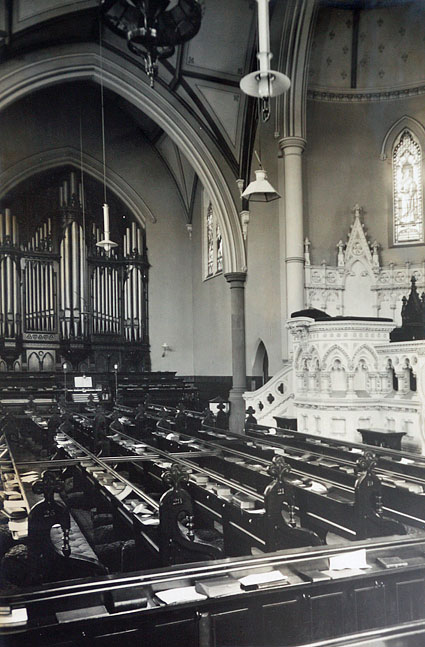
The Scots' Church, Melbourne: the organ following its rebuilding by Geo. Fincham & Son
also showing the original stone pulpit
[photograph by Simon Colvin from The Scots' Church Archives]
The organ was extensively rebuilt by George Fincham & Son in 1909 at a time when English-trained Herbert Palmer was on its staff. It was enlarged to four manuals, with new stopkeys and imported keyboards inserted within the original console cabinet, the fourth manual being an Echo Organ, with the pipes located above the south window and connected to the main organ by electro-pneumatic action, the first instance of its use by the Fincham firm. Tonal additions included a large Open Diapason 8 and a Wald Flute 8 to the Great Organ, the placing of the Swell Cornopean 8 on a unit chest and its extension to 16 and 4 pitches together with new string ranks, and a wooden Violone 16 to the Pedal.
SCOTS CHURCH ORGAN.The congregation of the Scots Church Collins-street, have just been spending £1,000 on the renovation of their fine organ. The old pipes were as good as new perhaps even better, for an organ pipe mellows with age, like a violin, but the mechanism was old fashioned and worn, most of it beyond the possibility of further use. A thorough overhaul of the instrument was made by Messrs Fincham and Son, and as the result it was determined to rebuild the organ, retaining the old pipes, but installing entirely new action and blowing plant. The work has been carried out entirely by that firm and the result shows that there is no need to go outside Melbourne in order to get the best and most modern style of instrument.
The bellows are the lungs of an organ, and unless they are ample the best pipes and mechanism are wasted. A completely new set of bellows has been provided blown by a powerful electric fan and capable of supplying the full power of the organ without a gasp or a tremor. The entire action is on the tubular pneumatic principle except in the case of the echo organ which is connected by an electric cable with the keyboard. The old fashioned drawstops have been replaced by stop-keys as in the Town-hall organ and every modern device for giving the performer the most perfect and instantaneous control of all the possible combinations of his instrument has been employed. Any desired combination can be prepared and brought on when wanted by the pressure of a single button. Changes can be made either by combination pedals or buttons placed under each manual at will. Two poppet tablets enable the player to couple or uncouple his pedals and manuals by a touch whilst the full power of the organ can be at any moment brought on by a single movement of the foot. The instrument has been retuned to normal pitch with the best effect both for choir and congregational singing; and a few new stops have been added by the advice of the organist (Mr. W.F.G. Steele) including an open diapason of noble quality on the great organ, some excellent string-tone stops, and some reeds on extra wind pressure. The effect is well balanced and satisfying. A new feature is the echo organ of five stops, which is placed in a swell-box over the large stained glass window at the south end of the church. Although so far away from the main instrument, the electric action causes it to speak instantaneously, and it is possible to play a solo on it with an accompaniment on the choir or swell organ without the slightest want of perfect synchronism. This is the first example of the kind in Victoria, and it renders possible a series of novel and striking effects.
The organ will be opened by Mr. Steele on Thursday March 17 when Sullivan's fine "Te Deum", composed for the thanksgiving service after the South African war, will be sung.5
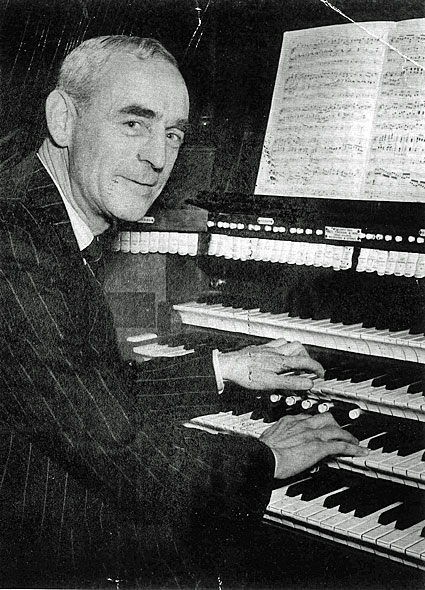
The Scots' Church, Melbourne: the 1909 console with organist Herbert Davis
showing the new stopkeys and keyboards
[photograph by John Maidment from The Scots' Church Archives]
It was rebuilt in 1959 with the addition of a number of stops, conversion of the action to electro-pneumatic, and provision of a new detached drawstop console, with the couplers controlled by stopkeys.
| GREAT Double Diapason Open Diapason I Open Diapason II Claribel Stopped Diapason Gamba Octave Clear Flute Twelfth Fifteenth Mixture Trumpet Clarion Swell to Great Sub Swell to Great Swell to Great Super Choir to Great Sub Choir to Great Choir to Great Super |
16 8 8 8 8 8 4 4 2-2/3 2 V 8 4 |
A B C D |
|
| SWELL Bourdon Open Diapason Gedact Viol d'Orchestre Voix Celeste Principal Flute Nazard Fifteenth Mixture Tromba Cornopean Oboe Clarion Tremulant Sub Octave Unison Off Octave |
16 8 8 8 8 4 4 2-2/3 2 IV 16 8 8 4 |
E TC F F F |
|
| CHOIR enclosed division Lieblich Gedact Gamba Dulciana Vox Angelica Suabe Flute Harmonic Flute Nazard Piccolo Tierce Clarinet Orchestral Oboe Tremulant bombarde division Open Diapason I Trumpet Clarion Tromba Cornopean Clarion Sub Octave Unison Off Super Octave Swell to Choir Echo to Choir |
8 8 8 8 4 4 2-2/3 2 1-3/5 8 8 8 8 4 16 8 4 |
TC B C D F F F |
|
| ECHO Gedact Gamba Vox Angelica Flute d'Amour Flautina Tremulant Sub Octave Super Octave |
8 8 8 4 2 |
(enclosed – placed over south window) TC |
|
| PEDAL Contra Bass Open Diapason Wood Open Diapason Metal Violone Bourdon Echo Bourdon Principal Viola Bass Flute Fifteenth Cornet Trombone Great to Pedal Swell to Pedal Choir to Pedal Echo to Pedal |
32 16 16 16 16 16 8 8 8 4 V 16 |
H A G H E I G H I variously derived |
Compass: 61/32
Electro-pneumatic action6
In 1992, the organ was overhauled by the South Island Organ Co. Ltd, of Timaru. New Zealand. Many of the ranks were regulated or revoiced and new Mixtures were inserted on the Great and Swell in place of the previous stops. This organ was removed to storage at the premises of Wakeley Pipe Organs Pty Ltd at Lilydale, Victoria in February 1999 and is now stored at the firm's Bayswater factory. It is destined for the Gulangyu Organ Museum in China.
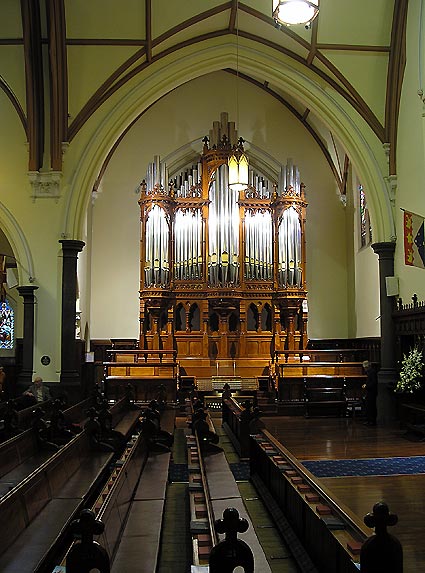
The Scots' Church, Melbourne: the main case of the Rieger organ
[photograph by Simon Colvin (May 2007)]
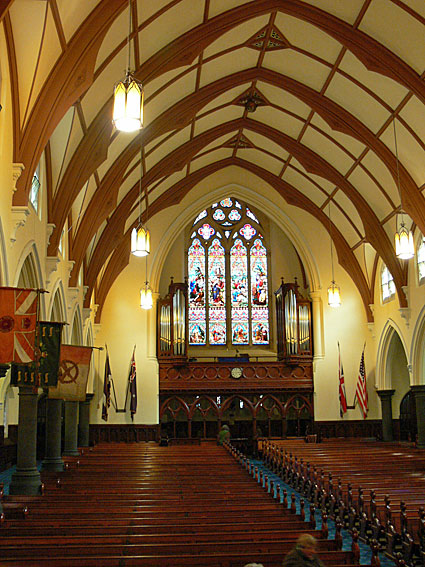
The Scots' Church, Melbourne: the case of the Gallery Organ
[photograph by John Maidment (17 July 2011)]
The present organ was built by Rieger Orgelbau, of Schwarzach, Austria, designed in association with the church's Director of Music Douglas Lawrence OAM, and was opened in 2000. It incorporates the cedar case, designed by Reed & Barnes, from the original organ of 1874, but fitted with new tin façade pipes. The case was raised, fitted with new side panels, and brought forward, adding greatly to its quality, balance and appearance. The organ is built on a grand scale, with the Pedal windchests placed at the rear and sides of the instrument, the enclosed Positive behind the arcades at the base of the case (previously fitted with solid panelling), the Great centrally placed behind the façade pipes, and the Swell to the rear. The fourth manual consists of a Gallery division, divided on either side of the south window behind new cases, and with a single manual and pedal console controlling the Gallery stops, which speak on electric action. The main console is terraced and detached from the instrument. The interior of the organ, superbly finished, is intersected by wide passageboards and ladders. The organ is undoubtedly the finest in any Australian church, on account of its excellence of construction and its outstanding sound; it has featured on several recordings.
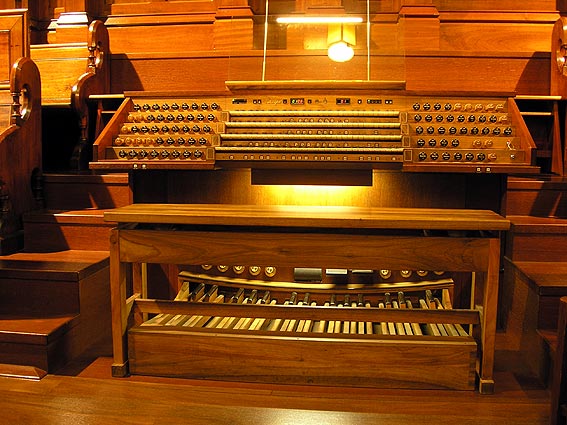
The Scots' Church, Melbourne: the console of the Rieger organ
[photograph by Simon Colvin (May 2007)]
| GREAT I Double Diap. Open Diapas. Harm. Flute Chimn. Flute Gamba Principal Open Flute Twelfth Fifteenth Mixture maj. Mixture min. Cornet Bombarde Trompette Clairon II / I III / I IV / I (electric) |
16 8 8 8 8 4 4 2-2/3 2 2 1-1/3 8 16 8 4 |
bass in façade A [IV] [III] [V] |
|
| POSITIVE II Open Diapas. Stopped Diap. Principal Chimn. Flute Fifteenth Larigot Sesquialtera Sharp Mixture Trompette Cromorne Tremulant Tromp. Royale III / II IV / II (electric) |
8 8 4 4 2 1-1/3 2-2/3 1 8 8 8 |
(enclosed) [II] [IV] B added March 2009 |
|
| SWELL III Bourdon Diapason Bourdon V. de Gambe Voix Céleste Principal Traversflute Viola Nasard Octavin Tierce Plein Jeu Basson Trompette h. Hautbois Voix humaine Clairon harm. Tremulant IV / III (electric) |
16 8 8 8 8 4 4 4 2-2/3 2 1-3/5 2-2/3 16 8 8 8 4 |
(enclosed) [V] |
|
| GALLERY IV Bourdon Echo Diapas. Gedackt Salicional Wood Princ. Chimn. Flute Fifteenth Mixture Tromp. Royale Tremulant Zimbelstern |
16 8 8 8 4 4 2 1-1/3 8 |
C D E F [IV] B |
|
| PEDAL Contrabass Open Diapas. Wood Diapas. Bourdon Principal Bass Flute Fifteenth Mixture Contrabomb. Bombarde Basson Trompette Clairon I / P II / P III / P IV / P (electric) |
32 16 16 16 8 8 4 2-2/3 32 16 16 8 4 |
stopped wood A open: tapered [IV] 1-12 wood: ½ length |
|
| GALLERY PEDAL Bourdon Echo Diapas. Gedackt Wood Princ. |
16 8 8 4 |
C D E F |
Compass: 58/32
Mechanical key action to Great, Swell, Positive and parts of Pedal
Electric key action to Gallery and major Pedal stops
Electric stop action
Balanced mechanical swell pedals
I Pl. / Ped.Pl.
IV PL. / I Pl.
4,502 pipes7
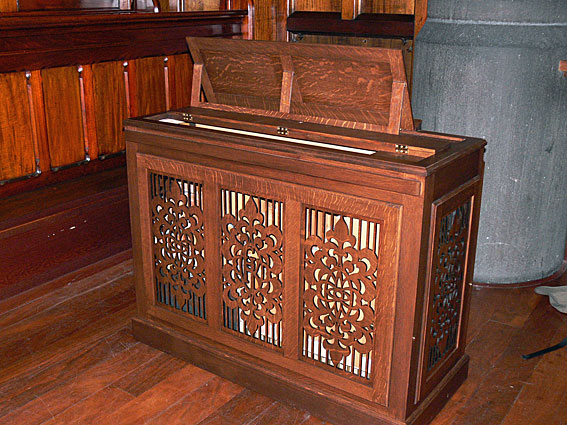
The Scots' Church, Melbourne: the Klop organ
[photograph by John Maidment (4 January 2013)]
A small portable continuo organ built by Henk Klop, Garderen, The Netherlands, was acquired late in 2012. It has three and a half speaking stops, with mechanical key and stop action. All of the pipework is constructed from wood and the casework is of waxed dark oak. The unnamed stops are controlled from small levers and are all divided between Middle C and Middle C#. The keycheeks are elegantly shaped.
| MANUAL | |||
8 4 2 Q |
[Bourdon] [Roerfluit] [Praestant] [Quint Treble 1-1/3, middle C# upwards] |
||
Compass: 54 notes, C-F
Mechanical key and stop action
Inbuilt blower8
There are other comparable instruments by this builder at the Early Music Studio, Parkville, the Melbourne Recital Centre, South Melbourne and at the Sydney Conservatorium of Music, MLC Burwood, Christ Church St Laurence, Sydney, and organs privately owned by Carey Beebe in Sydney and in Brisbane by Michael Fulcher.
1 The Argus, 27 November 1874, p.5
2 Ibid., 25 July 1876, p.7
3 The Scots Church, Melbourne: organ recital and concert by Mr J.R. Edeson 21 June 1883
4 The Argus, 22 June 1883, p.
5 Ibid., 8 March 1910, p.5
6 Specification noted 1962 John Maidment
7 Specification noted January 2013 John Maidment: stop designations taken from the drawstop faces; pipe total supplied by Rod Junor July 2018 and updated September 2018
8 Ibid.
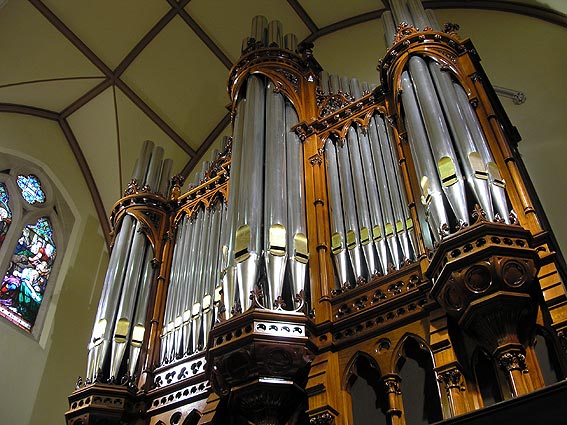
The Scots' Church, Melbourne: detail of the main case of the Rieger organ
[photograph by Simon Colvin (May 2007)]
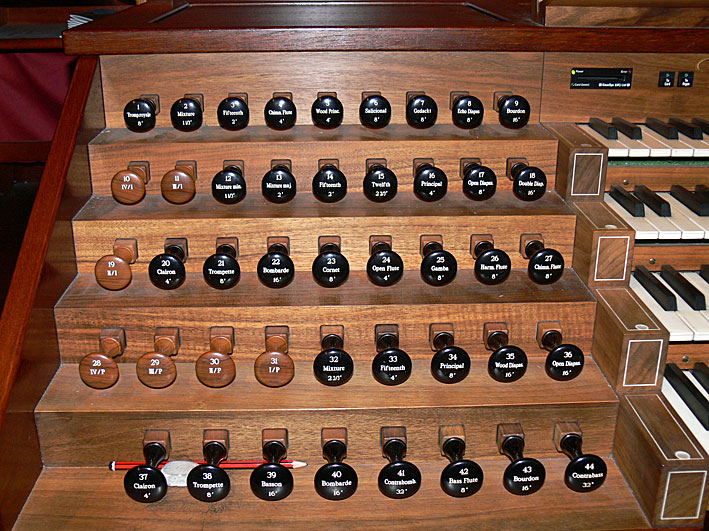
The Scots' Church, Melbourne: left-hand stop jamb of the Rieger organ
[photograph by John Maidment (4 January 2013)]
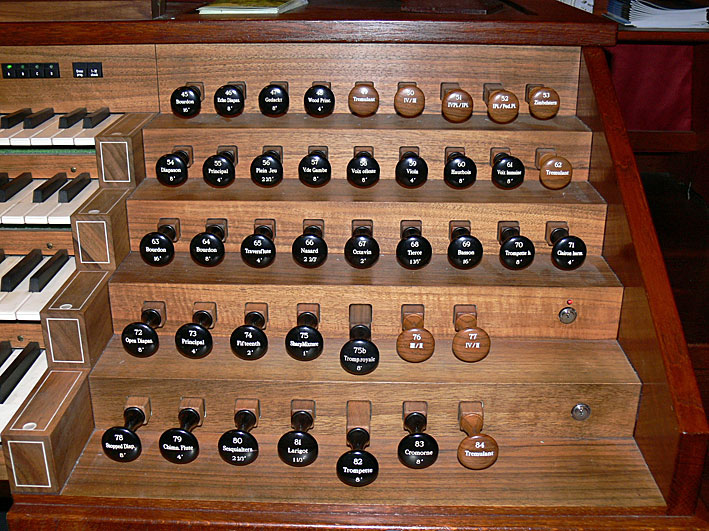
The Scots' Church, Melbourne: right-hand stop jamb of the Rieger organ
[photograph by John Maidment (4 January 2013)]
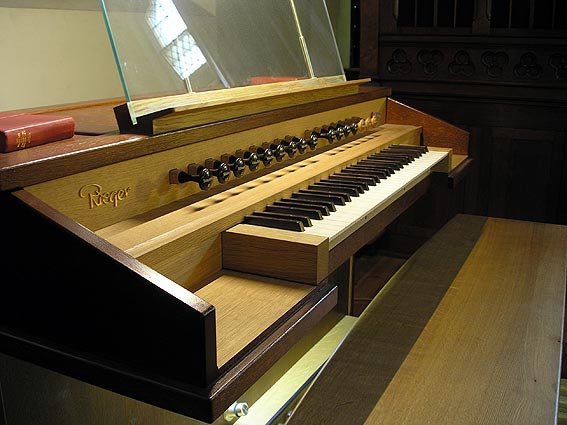
The Scots' Church, Melbourne: Gallery console of the Rieger organ
[photograph by Simon Colvin (May 2007)]
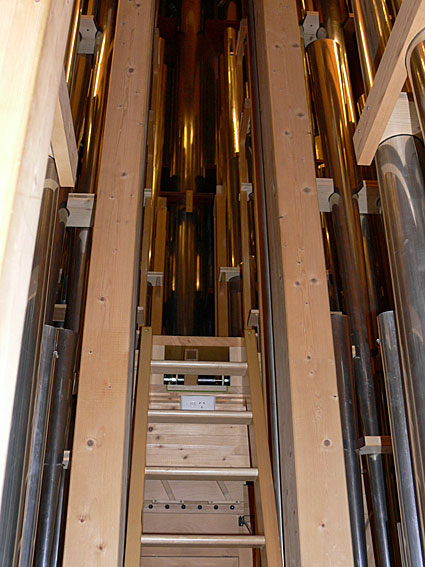
The Scots' Church, Melbourne: ladder intersecting windchests of the Pedal and Great of the Rieger organ
[photograph by John Maidment (4 January 2013)]
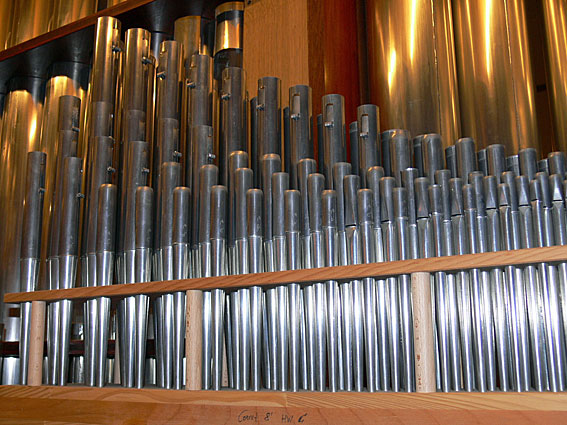
The Scots' Church, Melbourne: Cornet V ranks of the Rieger organ
[photograph by John Maidment (4 January 2013)]
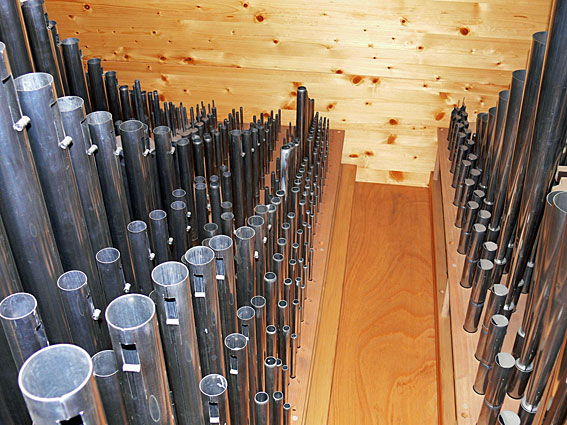
The Scots' Church, Melbourne: Swell pipework of the Rieger organ
[photograph by John Maidment (4 January 2013)]
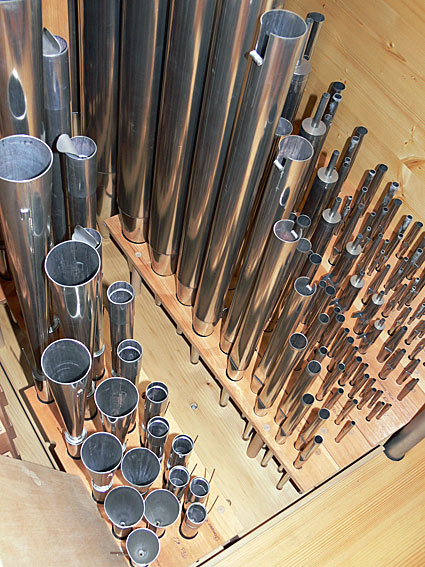
The Scots' Church, Melbourne: Positive pipework of the Rieger organ
[photograph by John Maidment (4 January 2013)]
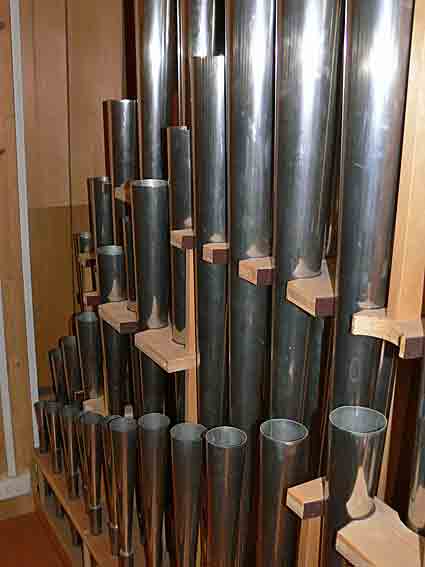
The Scots' Church, Melbourne: Pedal pipework of the Rieger organ
[photograph by John Maidment (4 January 2013)]
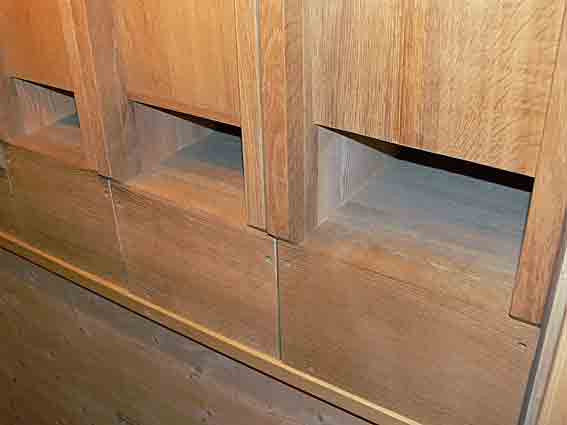
The Scots' Church, Melbourne: wooden pipework of the Contrabass 32 of the Rieger organ
[photograph by John Maidment (4 January 2013)]
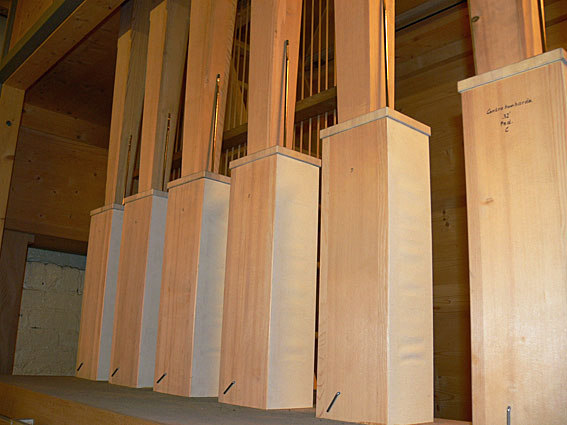
The Scots' Church, Melbourne: wooden boots of the Contre Bombarde 32 of the Rieger organ
[photograph by John Maidment (4 January 2013)]
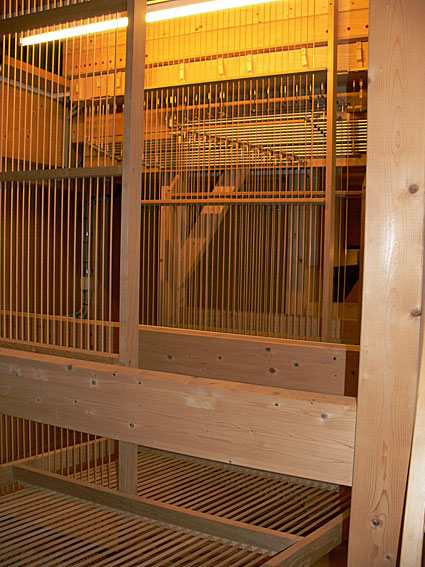
The Scots' Church, Melbourne: mechanical action runs of the Rieger organ
[photograph by John Maidment (4 January 2013)]
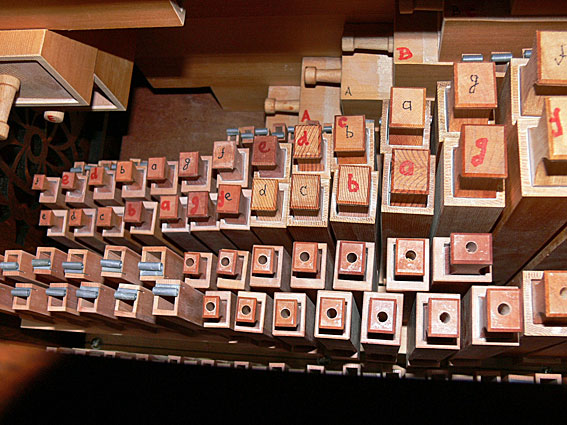
The Scots' Church, Melbourne: wooden pipework of the Klop organ organ
[photograph by John Maidment (4 January 2013)]
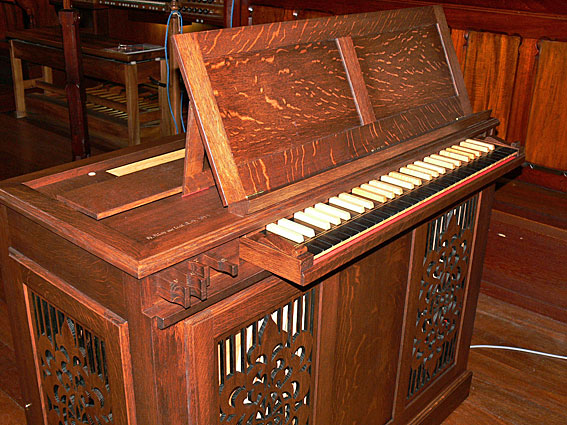
The Scots' Church, Melbourne: console detail of the Klop organ
[photograph by John Maidment (4 January 2013)]